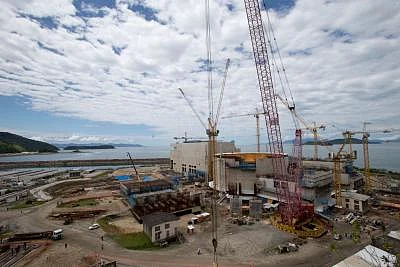New Delhi, Nov 29 (IANS) The quarterly growth figures for July-September to be released on Friday later by the Ministry of Statistics and Programme Implementation -- with most estimates pointing towards 4.3-4.7 per cent growth -- lower than Q1 growth of 5 per cent on the reasoning that the core sector and Industrial growth (IIP) both being dismal in August and September could have wrecked the Q2 numbers.
Finance Ministry sources do concede that core sector and IIP have been extremely poor in two months of the July-September quarter that will have a bearing on the GDP growth.
SKOCH Group Chairman Sameer Kochhar on Friday said Q2 number to be at 4.5 and double digit growth is required to meet $5 trillion target.
The country's largest public sector bank, State Bank of India, had released a report that predicts only a 4.2 per cent GDP growth in the second quarter. The bank attributes it to low automobile sales, deceleration in air traffic movements, flattening of core sector growth and declining investment in construction and infrastructure.
The growth forecast for FY20 has now come down to 5 per cent from 6.1 per cent earlier, the report said.
On Wednesday, In a heated Parliamentary debate on the economic slowdown affecting jobs, opposition parties said millions of people have lost their jobs and the country faces a "economic emergency".
In her reply, Finance Minister Nirmala Sitharaman said the economy faced a slowdown but no "recession" and cited several government measures to support economic growth.
On Thursday, she sought Parliament's approval to spend $2.7 billion in addition to a budgeted 27.86 trillion rupees ($388 billion) in the 2019/20 fiscal year.
Core Sector put up worst show in 14 years, shrunk 5.2 per cent in September and this is likely to have impacted most the second-quarter GDP growth, numbers, according to officials.
The Commerce and Industry Ministry said production in eight core sectors including coal, crude oil, natural gas, refinery products, steel, cement, and electricity declined in September. Coal contracted the steepest by 20.5 per cent; fertiliser being the only exception.
Core sector production contracted to over three-and-half year low of 0.5 per cent in August 2019 after growing 2.7 per cent in July that too when the government revised upwards the sector growth for July to 2.7 per cent from 2.1 per cent.
In September IIP contracted by 4.3 per cent, steepest fall in 8 years. Production for the mining, manufacturing and electricity sectors for September stood at 86.5, 126.5 and 158.7 respectively, with the corresponding growth rates of -8.5 per cent, -3.9 per cent, -2.6 per cent compared to September 2018.
The contraction was mainly due to the under-performance of the mining and electricity. As per the data, the core sector for the month of September contracted massively by 5.2 per cent from the 0.5 per cent contraction seen in August. The index was dragged down by coal mining which came in at minus 20.5 per cent.
The eight infrastructure industries of coal, crude oil, natural gas, refinery products, fertiliser, steel, cement and electricity have a 40.27 per cent weight in the index of industrial production (IIP).
Low core sector growth suggests moderation in industrial growth.
India's economy reported its weakest growth in more than six years at 5 per cent in the June quarter and slowed for the sixth straight quarter, prompting the government to unleash a spate of measures to spur economic activity.
Industrial growth (IIP) shrank 1.1 per cent in August, after a gap of 26 months, reinforcing fears of a slowing economy and deteriorating consumer sentiment.
Production of consumer non-durables, a barometer for the rural economy, rose 4.1 per cent in August but that of consumer durables, demand for which is more urban centric, shrank 9.1 per cent. Production of capital goods, an indicator of investment activity, contracted 21 per cent.
During July, manufacturing made a strong comeback, growing at 4.2 per cent, while electricity surprisingly decelerated, growing at only 4.8 per cent. Mining output grew at a robust pace of 4.9 per cent during the month. The pick-up in growth seems to have come on the back of intermediate goods, which grew in the double digits at 13.9 per cent even as capital goods contracted by 7.1 per cent. Consumer durables also shrank 2.7 per cent due to the slump in automobile sales while consumer non-durables grew at a healthy pace of 8.3 per cent.
--IANS
ana/sn/in
(At The Quint, we question everything. Play an active role in shaping our journalism by becoming a member today.)
